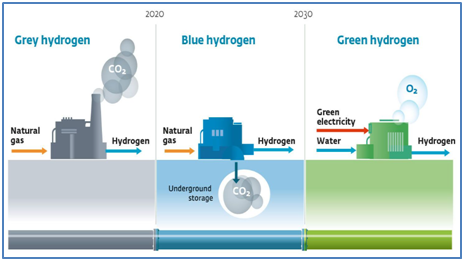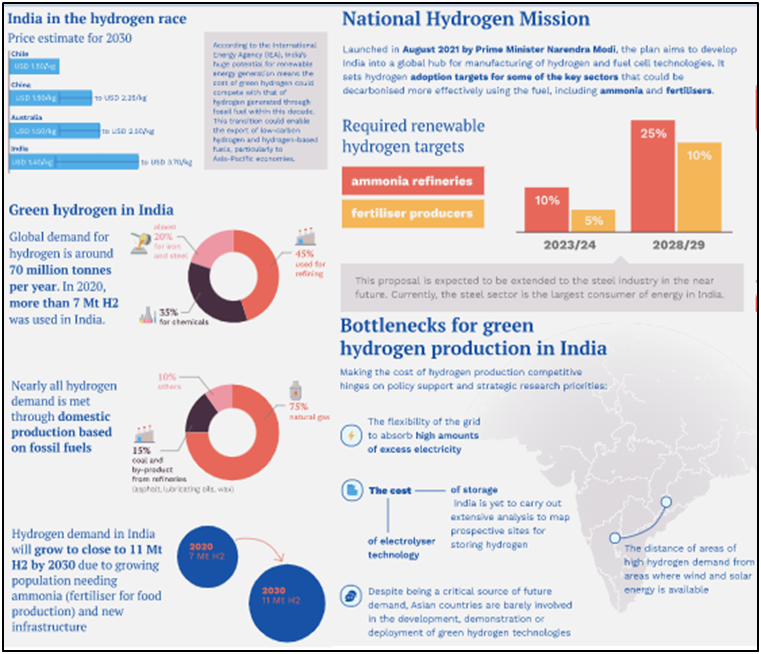Why in News?
- The Ministry of New and Renewable Energy (MNRE) notified the green hydrogen standard for India, outlining the emission thresholds for production of hydrogen that can be classified as ‘green’.
- The notification specifies that a detailed methodology for measurement, reporting, monitoring, on-site verification and certification of green hydrogen and its derivatives will be specified by the MNRE.
What’s in Today’s Article?
- What is Green Hydrogen?
- Applications of Green Hydrogen
- Highlights of the Green Hydrogen Standard for India
- India in Green Hydrogen Race
What is Green Hydrogen?

- Green hydrogen is the name given to hydrogen gas that has been produced using renewable energy, such as wind or solar power, which create no GHG emissions.
- Comparing with grey and blue hydrogen:
- While hydrogen gas does not emit GHGs when burned, the electricity used to produce it, may have been generated by fossil fuels. This is commonly known as ‘grey hydrogen’, which currently accounts for 95% of the total production.
- Hydrogen produced using electricity generated by burning fossil fuels, but paired with carbon capture and storage (CCS) technologies, which prevent GHGs from entering the atmosphere, is labelled ‘blue’.
Applications of Green Hydrogen:
- Globally, most of the hydrogen produced is used in the refining and industrial sectors - to make ammonia for the fertiliser industry and has applications in the steel industry.
- In developing countries such as India, which is investing in the National Hydrogen Mission, hydrogen could be used in transportation, power generation and industry.
- By the end of the decade, the International Energy Agency (IEA) anticipates that hydrogen will find a host of new applications, including powering grids and fueling the building and transportation sectors.
Highlights of the Green Hydrogen Standard for India:
- Defines green hydrogen: It is defined as having a well-to-gate emission of not more than two kg carbon dioxide (CO2) equivalent per kg hydrogen (H2).
- India became one of the few countries to have a definition for green hydrogen.
- The well-to-gate emission includes: Water treatment, electrolysis, gas purification, drying and compression of hydrogen.
- The scope of the definition encompasses both electrolysis-based and biomass-based hydrogen production methods.
- Nodal authority for accreditation: The notification specifies that the Bureau of Energy Efficiency (BEE) under the Ministry of Power will be the nodal authority for accreditation of agencies.
- These agencies will take care of the monitoring, verification and certification for green hydrogen production projects.
India in Green Hydrogen Race:

- The government launched the National Green Hydrogen Mission (Jan, 2023) with an aim to produce 5 million metric tonne (MMT) green hydrogen per annum with an associated renewable energy capacity of about 125 giga watt (GW) by 2030.
- The mission has an outlay of Rs 19,744 crore up to 2029-30.
- The Strategic Interventions for Green Hydrogen Transition (SIGHT) programme is a major financial measure under the mission with an outlay of Rs 17,490 crore.
- The programme proposes two distinct financial incentive mechanisms to support domestic production of electrolysers and production of green hydrogen.
- These incentives are aimed at enabling rapid scale-up, technology development and cost reduction.
- The definition of green hydrogen brings a lot of clarity to the mission of making India a global green hydrogen hub.









